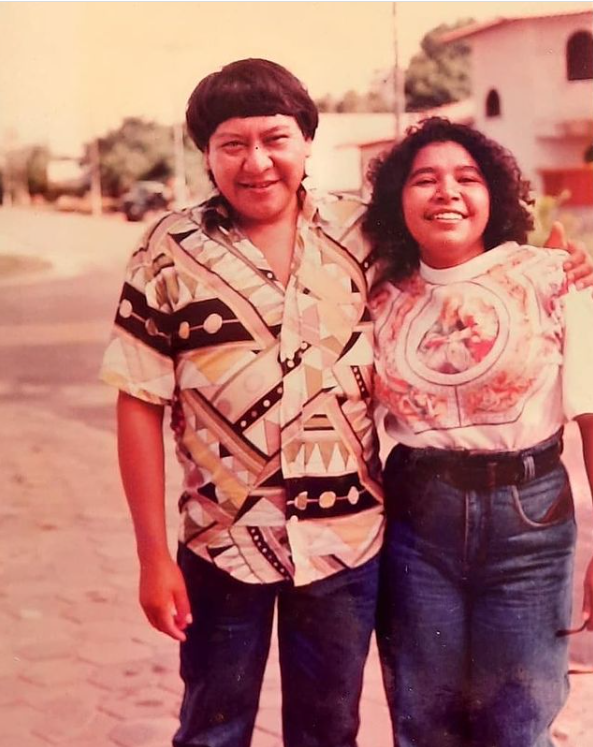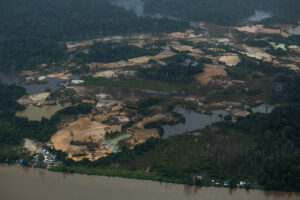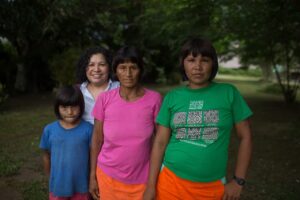Brazilian journalist Kátia Brasil has 37 years of professional career and 33 years in the Amazon. The forest and its peoples inhabited her dreams as a young journalist who left Rio de Janeiro for Boa Vista in the state of Roraima in 1990. Faced with the high expectations of any recently graduated journalist, the start in the new city was disappointing, and she almost gave up on her career. But when she got a job at a newspaper that "opened the doors to the Amazon," as she told LatAm Journalism Review (LJR), Brasil began to consolidate the work that, more than three decades later, stands out nationally and internationally through the Amazônia Real news agency, of which she is cofounder and co-director and which turns 10 years old in 2023.
Since its foundation, Amazônia Real has stood out for centralizing coverage of the region from the perspective of the populations that live there, with an editorial line "focused on the defense of the democratization of information, freedom of expression, press freedom, and human rights," according to its website. Its investigative journalism is inspired by other innovative and renowned news outlets such as Agência Pública, from Brazil, El Faro, from El Salvador, and Propublica, from the United States.

Amazônia Real is today one of the most awarded media in Brazil. Among the recognitions in recent years are the King of Spain Award 2018, as an outstanding news outlets in Ibero-America; the tribute from the Brazilian Association of Investigative Journalism (Abraji, by its Portuguese acronym) to Kátia Brasil and Elaíze Farias, co-founders of the agency, during the 16th International Congress of Investigative Journalism, in 2021; and the Vladimir Herzog Special Award in 2022 to Brasil and Farias.
Also in 2022, Amazônia Real was a finalist for the 30th Annual Reporters Without Borders (RSF) Press Freedom Award, in the Impact category. The RSF award jury highlighted the agency's coverage of the murders of British journalist Dom Phillips and Indigenous affairs expert Bruno Pereira, killed in the Javari Valley in the Amazon in June 2022. It also stated that “the national media have picked up its recent reports about clashes between police and illegal gold panners, the use of new industrial pesticides and the seizure of land from local communities.”
The coverage of illegal mining on Indigenous lands and its impact on native peoples and the environment has been present in Amazônia Real since its inception. In the life of Kátia Brasil, it has been present for 32 years, since she met the Indigenous leader Davi Kopenawa Yanomami and accompanied Indigenous protests in Boa Vista against the invasion of miners and the illegal exploitation of their territories. This scenario has worsened over the past four years in Brazil, fueled by former president Jair Bolsonaro's encouragement of illegal mining and his neglect of Indigenous peoples. In early 2023, this humanitarian emergency finally came to the fore in the national media, after the publication of a story by the journalism platform Sumaúma with photos of malnourished Indigenous children in the Yanomami territory, where illegal miners have been bringing violence, disease, and death to the Indigenous people.
"For all major events in the Amazon region, the mainstream media shows up and does a quick, temporary coverage. And then, everything is forgotten," Brasil said. "The images of malnourished children, starving, have gained international prominence. But today you don't see any outcry about this [in traditional media] anymore."
LatAm Journalism Review (LJR) spoke with Katia Brasil about these and other topics, such as the safety of journalists in the Amazon region sparked by organized crime in collusion with state actors and the relationship of the new Brazilian government, led by President Luiz Inácio Lula da Silva, with the press.
Read the interview below, which has been edited for clarity and conciseness.
1. You graduated and began your career as a journalist in Rio de Janeiro and in 1990 you moved to the Amazon. Why did you choose to dedicate your journalism work to this region?
Kátia Brasil: In 1990 I was a recent graduate of a journalism class in Rio de Janeiro. I was invited to participate in a selection process to work for a newspaper in the state of Roraima and I ended up passing. I was very interested in working in the Amazon, because I wanted to write great stories. That was my dream, which had a lot to do with the stories I read about Zuenir Ventura in Jornal do Brasil. The newspapers I read at the time published very few stories about the peoples of the Amazon. And these stories were precisely about mining in the Yanomami Indigenous Territory, in Roraima, and about mining in Serra Pelada, in Pará, which was gaining a lot of space in the media.
In the first nine months that I spent in this newspaper [in Roraima], I didn't have the opportunity to write about the indigenous peoples, because this topic was not of interest to the newspaper’s editorial. I ended up staying more in the newsroom, taking care of the flow of articles, and rarely went out into the street.
At the end of 1990 I went back to Rio de Janeiro. The situation in Rio was not good for journalists, there was a crisis in the profession, and work for new graduates was still difficult. I am a woman of humble origins, a Black woman. Today I am aware that this weighed heavily on me and I did not realize it, because the doors of the big newsrooms were not easily opened to me. The only place that opened the door for me was the Amazon region, and I went back there in 1991 to work for the newspaper A Gazeta de Roraima. This newspaper did open the doors to the Amazon for me, because through it I was able to interview the Indigenous peoples. I also had an editor, Plínio Vicente da Silva, who taught me how to be a correspondent. As I had already done some freelance work for the newspaper O Globo, I went to the editorial office in Brasilia and asked to be the correspondent in Roraima and I got it. With the Gazeta we won the Esso Award, in 1991, for a feature story I did on the territorial conflict between Venezuela and Brazil over Brazilian gold miners.

Davi Kopenawa Yanomami and Kátia Brasil in 1992. (Photo: Courtesy / Kátia Brasil)
I started to visit Funai [the Brazilian National Indian Foundation], where I met leaders of the Indigenous peoples, and began to forge great bonds. I met [Indigenous leader] Davi Kopenawa Yanomami there in 1991, and I accompanied Indigenous protests in Boa Vista, already against mining, the exploitation of the territories, and the miner invasion. So this story has been in my life for 32 years.
2. We talked in June 2022 about the risks for journalists covering illegal activities in the Amazon region, which became evident after British journalist Dom Phillips was murdered along with Brazilian Indigenous leader Bruno Pereira, whom he was accompanying in the Javari Valley region. What is your assessment of the safety of journalists in the Amazon since then?
The question of the safety of journalists in the Amazon needs to be seen from three angles: First, from journalists who work in the newsroom and write stories on politics and corruption that go against the interests of politicians and businessmen in the region. These journalists can be fired at any time if a story displeases politician A, B, or C; or for going against the interest of a mining businessman, for example, who pays for the newspaper's advertising. When threats occur, it is difficult for companies to protect journalists.
The second issue is the way in which the local press has dealt with topics from the official point of view. Official agencies, such as the state government, city hall, and state-owned companies are producing press releases as if they were feature stories. These press releases are published in full in newspapers, websites and blogs. Sometimes a press release even replaces an article by a journalist who went to the field because his text will go against the interests of the governor or the mayor. This is very serious and violates freedom of expression and freedom of the press. Many websites and printed newspapers publishing the same press releases cause the population to lack critical sense, and this also is an affront to democracy. So this is a serious problem that also leaves journalists feeling vulnerable and threatened.
And the third issue is the journalist that goes into the field, that enters conflict areas, that goes from the newsroom to several states in the Amazon, as is the case of Amazônia Real’s journalists. Today we have a safety plan, but even before that we already had methods to work in the field so that a journalist can return home safely. For example, you cannot travel at night; it is always good to travel during the day. You don't travel in the car of a threatened leader or activist because this person will be more at-risk sitting next to a journalist. And we rarely let a journalist travel alone. It is always a duo, always a man and a woman, in order to also bring equity to the front line of reporting. In certain territories we have already stopped going on site to investigate a situation because of the level of threats against the leadership. In this case, the option is to interview this leadership through WhatsApp or another safer network.
We must also highlight what happened during the Bolsonaro government, which created a hostile environment against journalists. We are now living a new moment, and it is necessary for the safety mechanisms [for journalists] to be revalidated and supported by the federal government, so that what happened in the Javari Valley does not happen again to anyone.
3. In recent weeks there has been public outcry over the situation of the Yanomami Indians, who are under siege from illegal mining that has brought violence, disease, and hunger to Indigenous land. Major Brazilian news outlets have ostensibly started covering this issue, which Amazônia Real has been covering since at least 2020. What is your opinion about this "delay" of big media in coverage, and what lessons are left for you, from Amazônia Real, and for big media on this issue?
In fact, Davi Kopenawa Yanomami has been denouncing the resumption of garimpo [informal mining] since 2013. In 2019, he gave an interview to Amazônia Real in which he said that there were between 10,000 and 15,000 miners in Yanomami Indigenous Land. Before, in 1991, his denunciations led the government to remove 40,000 miners and demarcate the territory in 1992.

Illegal mining area in Indigenous Yanomami Territory, in April 2021. (Photo: Bruno Kelly/Amazônia Real)
This informal mining really took shape in the last four years, during the Bolsonaro government. A series of violations and a very big takeover began, with many men illegally exploiting the territory, destroying rivers and deforesting the forest. This was undoubtedly a determining factor for the calamity that the Yanomami territory is today in the state of Roraima.
In 2021 we did a big special story on the ground, showing the illegal production chain of gold and cassiterite exploitation, which are two minerals of high value in the national and international trade. This story came out of a question that has always intrigued me: Who sells and buys gold? We show who are the businessmen and politicians behind these crimes.
In all major events in the Amazon, big media appears and makes quick, temporary coverage. And then, everything is forgotten. TThe images of malnourished children, starving, have gained international prominence. But today you don't see any outcry about this [in traditional media] anymore. People have already turned the page.
On this point, Amazônia Real will continue until the end, because this is a great characteristic of ours: We’re always covering Amazonian issues in depth and bringing the narratives of Indigenous peoples first, especially those who are on the land fighting for the survival of their peoples.
4. While the four years of former president Jair Bolsonaro's administration registered record rates of deforestation and consolidated the presence of organized crime in the Brazilian Amazon, the government of current president Luiz Inácio Lula da Silva promises zero deforestation, to remove illegal mining from Indigenous lands and combat organized crime in the region. How does this change in the federal government's stance impact journalistic coverage of the Amazon region?
We’ve already had a breath of fresh air with this change of government. Because, in the last four years, we had no answers about anything. We didn't do an interview, for example, with the Minister of Health. It was impossible to interview any government official. They all refused to talk to the press. Today we have an open channel, no doubt.
The Lula government promises zero deforestation and the withdrawal of miners from invaded Indigenous territories, and we are waiting for this to actually happen, so that these populations can live in peace. We are waiting for the actual measures, the main one being the demarcation of Indigenous and Quilombola Afro-Brazilian territories.

Kátia Brasil with Kinja Indigenous women, in 2019. Photo: Bruno Kelly/Amazônia Real
We’re still watching the impact of the new government on coverage. I get a little afraid when Lula's government invites journalists for breakfast and has the traditional press over one day and the independent, alternative press over on the other day, as if the press shouldn’t mix. I don't really understand this, I don't know why we have these divisions. I believe that all news outlets should be treated equally. All are professional journalists, there is no difference. I think the government still doesn't understand that the independent press is as important as traditional media. It is not a case of separating us, on the contrary: It would be interesting if the government brought all media together and that all were represented in coverage in an equal way. We see privilege all the time. And I'm not talking about advertising resources or incentives because we don't receive public resources, that’s why we are independent. This is a question of congruence with our work.
5. Amazônia Real has entered its tenth year. What is your balance about the work done and the impact achieved in this period, and what do you think remains to be accomplished?
Amazônia Real reaches its 10th year with many challenges ahead. We work in a region where there is no empathy from the population towards the forest and its peoples. Unfortunately, this is reality and it’s very difficult. Most of our readers are in São Paulo, Rio de Janeiro, Belo Horizonte, and Goiânia. In the cities of the Amazon, as much as we make an effort with our network of local reporters, who do stories in the cities or go to the interior of the nine states of the Amazon, we see that working inside the Amazon still requires a lot of attention and effort. Amazônia Real is not well known, as we would like it to be, in the very region where we work. We still have a lot of work to do to reverse this situation.
Our coverage has had a very big impact. We have won international and national awards on several occasions, and we have several partnerships with press organizations and associations that defend journalism. Abraji and Media Defence, for example, are funding our lawyer to follow up on the lawsuits that businessmen have filed against our stories. One of them has been censored for seven months, because it goes against the interests of businessmen in Manaus.
The partnerships have made us grow, mature, and plan for the future. What do we want to be 10 years from now? Amazônia Real will certainly dive deeper to occupy spaces that today are, for example, news deserts. We want to reduce this statistic, and also make the population of the Amazon have a more loving and careful look at their own region and its peoples.